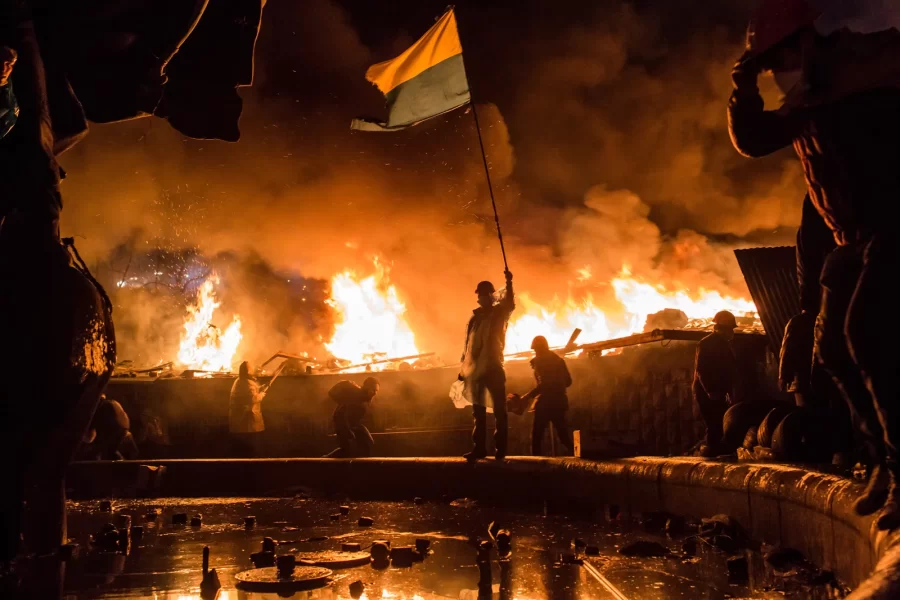Your donation will support the student journalists of Rancocas Valley Regional High School. Your contribution will allow us to enter into regional and national competitions, and will help fund trips to journalism conferences to continue to improve our writing and work!
How did we get here? A brief history of the Russian-Ukranian conflict
The two countries have been intertwined for decades
March 4, 2022
Anti-government protesters guard the perimeter of Independence Square, known as Maidan, in Kyiv on Feb. 19, 2014. Protesters were calling for the ouster of President Viktor Yanukovych over corruption and an abandoned trade agreement with the European Union.
With growing tensions between Ukraine and Russia, knowing the complex history of the two countries is important in understanding why they are in a conflict now, especially as Russia continues to launch attacks on its former territory.
After Ukraine gained independence from what was then known as the Soviet Union on August 24, 1991, the newly founded country fought to join the North Atlantic Treaty Organization (NATO) but was met with resistance from the Soviet Union.
In December of 1994, the Soviet Union fell and Ukraine signed the Budapest Memorandum on Security Assurances to remove Russian nuclear weapons from their borders in exchange for “respect the independence and sovereignty and the existing borders of Ukraine.” from the United States, the United Kingdom and Russia.
According to “Radio Liberty,” “In return, Russia and the Western signatory countries essentially consecrated the sovereignty and territorial integrity of Ukraine as an independent state. They did so by applying the principles of territorial integrity and nonintervention in 1975 Helsinki Final Act — a Cold War-era treaty signed by 35 states including the Soviet Union — to an independent post-Soviet Ukraine.”
By the early 2000’s, Ukraine was working to improve upon its economic opportunities with President Leonid Kuchma spearheading the effort. Overshadowing the country’s strides towards progress, accusations of election rigging were launched, and Viktor Yanukovych, the candidate that Vladimir Putin, the president of Russia, supported ultimately won the election.
According to NPR, “[NATO] promised that Ukraine will one day be a member of the alliance but [did] not put it on a specific path for how to do so,” as Ukraine continued to fight for membership in the alliance. The potential of having a NATO nation on the border of Russia was widely seen a a threat to Russia’s rising autocratic power.
In February of 2014, the Maidan Revolution ensued after President Yanukovych refused to sign a European trade agreement and a series of violent protests occurred claiming the lives of countless protestors.
The new disapproval of Yanukovych led to his removal from office, and he left behind an interim Ukrainian government elected by Parliament. The shift of power from Yanukovych caused Russia to accuse Ukraine of staging an illegal coup, and Putin placed soldiers in the Crimean peninsula by March 2014.
Following Russia gaining control of Crimea, two regions, Donetsk and Luhansk, seceded from Ukraine and Russian troops continued to invade Ukrainian territory, particularly in Donbas where violence broke out. Roughly 13,000 Ukrainian civilians would be killed in the conflict.
According to NPR, “As fighting in the Donbas continue[d], Russia repeatedly [attacked] Ukraine in a series of cyberattacks, including a 2016 attack on Kyiv’s power grid that causes a major blackout. In 2017, a large-scale assault affects key Ukrainian infrastructure, including the National Bank of Ukraine and the country’s electrical grid.”
In late 2021, Putin began referring to what he called “special military operations” on the Ukrainian border, and send thousands of troops to conduct exercises throughout the month of February 2022. For months, Washington had actually warned of an impending invasion, which was later dismissed and even parodied in Russian media, which had amped up its anti-Ukrainian propaganda.
On February 24, Channel 1, a Russian state-controlled media outlet, announced an “historic moment.”
The announcer claimed that the residents of separatist-occupied eastern Ukraine were being subjected to “genocide” by Ukrainian forces, and that Russian military troops would be putting a stop to it.
According to NPR, “On Feb. 24, Russian forces launch[ed] a devastating assault on Ukrainian territory — the largest such military operation in Europe since the end of World War II.”
While the rest of the world condemned Russia’s aggression, Putin continued to defend the invasion, calling it a defense to against NATO-expansion, even claiming that Ukraine is not its own autonomous nation.
“Let me emphasize once again that Ukraine for us is not just a neighboring country,” Putin said on February 21. “It is an integral part of our own history, culture, spiritual space.”
Despite continued aggression — including Russian troops closing in on the captial, Kyiv — Ukrainian President Volodymyr Zelensky continues to encourage the Ukrainian people.
“If they [Russia] attack, if they try to take our county – our freedom, our lives, the lives of our children – we will be defending ourselves,” he said on February 22.
As of publication time, Russian forces recently took control of the Zaporizhzhia plant in southeastern Ukraine following an attack overnight, which caused a fire that led to widespread alarm throughout the region. Experts say that there has been no release of radioactive material. The attack continues as Russian troops move deeper throughout southeastern Ukraine. Zelensky has renewed calls for talks with Russia following the attack.
A brief timeline of key dates in the Russian-Ukrainian conflict
